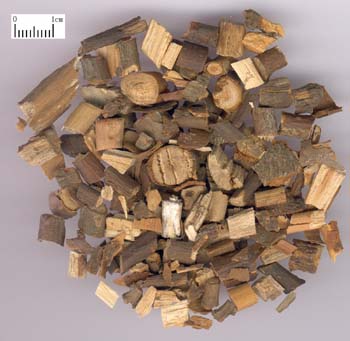Gui Zhi
The Processing of Gui Zhi
Origin
Burgeon of arbor plant Cinnamomum cassia Presl of family Camphor.
Location
Guangxi anc Guangdong provinces of China.
Harvest
Burgeon cut from March to July.
The real smell and taste
Special fragrant smell, pungent, spicy and slightly sweet taste.
Best quality
Tender, brown, red colour with fragrant smell.
Processing
Sliced into pieces or segment, cooled and dried, unprocessed.
The Effect of Gui Zhi
Property
Pungent, sweet, warm; lung, heart, kidney, liver meridians entered.
Actions
Induce sweating and release exterior, warm and unblock the meridians, warm and reinforce the yang qi.
Indications
A. Wind-cold exterior syndrome
The ability of this herb to induce sweating and release exterior is more moderate than that of Ma Huang. Moreover, it can activate the yang qi, smooth and promote the movement of blood. It is indicated for exterior wind-cold whether for exterior excess without sweating, exterior deficiency with sweating or yang deficiency with cold. It is indicated for wind-cold exterior excess syndrome since Gui Zhi can assist Ma Huang in inducing sweating and releasing exterior. It can also activate the yang qi, smooth and promote the flow of blood to treat headache and body pain due to exterior cold. For instance, Ma Huang Tang from Shang Han Lun. It is indicated for wind-cold exterior deficiency syndrome, spontaneous sweating due to disharmony of nutrient and defensive qi, and those with a floating and moderate pulse. Gui Zhi is combined with Bai Shao to regulate the nutrient and defensive qi. For instance, Gui Zhi Tang in the Shang Han Lun. It is indicated for colds with preexisting yang deficiency. This herb disperses Wind-cold in the exterior and warms interior yang qi. Ir is often combined with Fu Zi to assist the yang and release exterior.
B. Syndrome of congealing cold with blood stasis, wind-cold arthralgia and other types interior cold syndrome
The action of this herb is to warm the meridians and dispel cold. It can smooth and promote the movement of blood to invigorate blood. For this reason it is indicated for syndrome of congealing cold with blood stasis, wind-cold arthralgia and other types of interior cold syndromes. It is indicated for cold in the meridians, cold congealing blood stasis, with irregular menstruation, dysmenorrhea, mass, postpartum abdominal pain and other cold invasions after an injury, pain and swelling and other types of stagation with cold. It can be used with any of the blood activating and stasis resolving herbs. It is indicated for wind-cold arthralgia. This herb is used with herbs that dispel wind-damp and herbs that alleviate pain. Because its nature is ascending and floating, it is good for moving upward and is suitable for the arthralgia of the upper limbs, shoulders and upper back. This herb is effective for headache from cold in the meridians, abdominal pain and deep rooted carbuncle of yin type.
C. Yang deficiency syndromes
Because this herb can warm and assist the yang of the heart, kidney (bladder) and spleen, it can be used for all kinds of yang deficiency syndromes. It is indicated for depression of the heart yang, blockage of the heart vessels, with symptoms of chest stagnation pain or heart palpitations and irregular heartbeat. This herb can warm and activate the heart yang to invigorate blood and restore the pulse. It is usually combined with herbs that ventilate, open, and disperse accumulation, activate blood and resolve stasis, and tonify the heart qi. For instance, it is used in Zhi Shi Xie Bai Gui Zhi Tang from the Jin kui Yao Lue which is primarily indicated for depressed chest yang and chest impediment from qi accumulation and phlegm blockage. Gui Zhi Gan Cao Tang from the Shang Han Lun is primarily indicated for heart palpitations from damage to the heart yang. It is indicated for spleen yang not transporting, phlegm and dizziness due to retention of water and dampness. This herb is usually combined with Bai Zhu, Fu Ling and other herbs that tonify and benefit the spleen qi, expel dampness and resolve phlegm. For instance, Ling Gui Zhu Gan Tang from Jin Kui Yao Lue is indicated for kidney and bladder yang deficiency with cold congealing, inhibited urination from qi not transforming and edema. This herb is usually used with herbs like Fu Ling and Zhu Ling that promote urination, and have the action of warming yang to transform qi, and moving water to promote urination. For example Wu Ling San from the Shang Han Lun.
Dosage and Administrations
Decoct 3~10g. For external application, it is applied at an appropriate amount.
Cautions
This herb induces heat, damages the yin and moves blood. It is prohibited for those with warm pathogens, yin deficiency with effulgent fire, or reckless movement of the blood due to heat in the blood. Use with caution in pregnant women.
